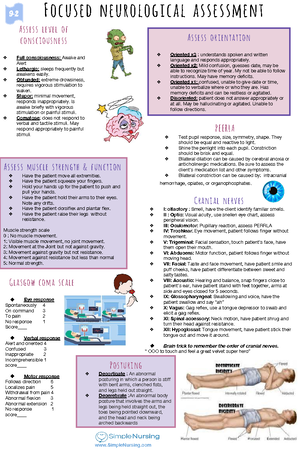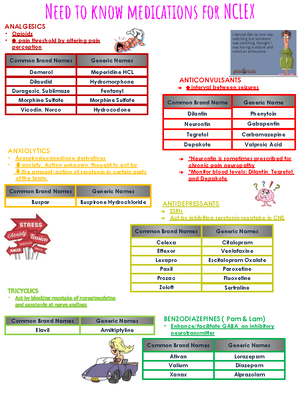- Information
- AI Chat
Was this document helpful?
Cc 14 burns
Course: Critical Care (408)
18 Documents
Students shared 18 documents in this course
University: Loma Linda University
Was this document helpful?

Role of Skin Depth of Burns Primary Survey
body temperature
regulation
maintain fluid/electrolyte
balance
protect from infection &
injury
skin – largest organ
sensory contact w/
environment
vitamin D activation
able to regenerate itself
Superficial – 1st degree
only damage the
outermost layer of the
skin
epidermis (sunburn)
burn appearance
red, pink
no blisters & dry
PAINFUL
usually heals in a few
days (2-7 days)
Partial Thickness – 2nd
degree
damages epidermis and
dermis
can extend into the dermis
deep partial thickness
burn
burn appearance
red
some edema, shiny
swollen, wet, has
blisters
VERY PAINFUL
usually heals in 2 weeks
(7-21 days)
deeper it is longer the
healing
Full Thickness – 3rd
degree
affects ALL layers of skin
usually feels NO PAIN
(burned the sensory
nerves)
no increase in pain when
pressure applied to wound
burn appearance
(charred)
tough & leathery
white, brown, black, red,
lots of color variation
very dry
can NOT grow new skin
treatment: skin graft &
surgical excision of wound
Airway (INTUBATE ASAP
BEFORE SWELLING OCCURS)
maintain airway & constantly
reassess
administer supplemental O2 at
100%
intubation to protect airway
Inhalation Injury (look in the
mouth)
suspect inhalation injury if
enclosed space
fumes, smoke can trap inside
stridor, hoarse, or raspy voice
carbonaceous sputum
singed (slightly burned)
facial/nasal hairs
occurs in presence or absence of
cutaneous (skin) injury
carbon monoxide poisoning
major predictor of mortality in
burn victims
administer oxygen 100% by
mask
Classification of Burns
depth
1st degree - superficial
2nd degree - partial
thickness
3rd degree - full thickness
extent in percent of total
body surface area (TBSA)
rule of 9’s (NOT for 1st
degree burns)
location
patient risk factors
type: thermal, chemical,
electrical, radiation
Breathing
listen to verify breath sounds
each lung
assess adequacy of rate and
depth of respiration
burns to chest wall lead to
decreased COMPLIANCE =
requires higher vent
pressures to provide patient
w/adequate tidal volumes
circumferential full thickness
burns of the trunk may impair
ventilation & should be closely
monitored
Escharotomy
(eschar – dead tissue
extensive burn injury)
treatment for circumferential
burns
can be done bedside or in OR
cuts made thru inelastic eschar
(mechanical, chem, surg)
eschar: piece of dead tissue
cast off surface of skin
return of blood flow through
body part
Burn Injury - Physiology
immediate release of
catecholamine & other
mediators
↑BP (HTN)
↑ HR (tachycardia)
vasoconstriction
disrupted blood flow
increased capillary
permeability
edema everywhere
including lungs
pulmonary edema
hypovolemia (low blood
volume)
massive fluid shift
↑HR (tachycardia)
low CO
decreased perfusion to GI
system
paralytic ileus
abdominal distention
stress ulcer
inflammatory response
destroyed skin
immunosuppression
risk for infection/sepsis
loss of ability to sweat
Circulation
burns do NOT bleed
assess BP, skin color, peripheral
pulses
Skin Graft
excision and grafting
done in OR on day 1 or day 2













